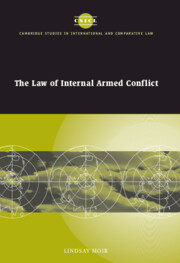Book contents
- Frontmatter
- Contents
- Preface and acknowledgements
- Table of cases
- Table of treaties and other international instruments
- 1 The historical regulation of internal armed conflict
- 2 Article 3 common to the Geneva Conventions
- 3 Additional Protocol II of 1977
- 4 Customary international law and internal armed conflict
- 5 Human rights during internal armed conflict
- 6 Implementation and enforcement of the laws of internal armed conflict
- Bibliography
- Index
- CAMBRIDGE STUDIES IN INTERNATIONAL AND COMPARATIVE LAW
1 - The historical regulation of internal armed conflict
Published online by Cambridge University Press: 07 July 2009
- Frontmatter
- Contents
- Preface and acknowledgements
- Table of cases
- Table of treaties and other international instruments
- 1 The historical regulation of internal armed conflict
- 2 Article 3 common to the Geneva Conventions
- 3 Additional Protocol II of 1977
- 4 Customary international law and internal armed conflict
- 5 Human rights during internal armed conflict
- 6 Implementation and enforcement of the laws of internal armed conflict
- Bibliography
- Index
- CAMBRIDGE STUDIES IN INTERNATIONAL AND COMPARATIVE LAW
Summary
It is perhaps trite to observe that non-international, or internal, armed conflicts have been commonplace throughout history. They have occurred for a variety of reasons, such as the desire to overthrow one government and replace it with another, or the desire of one or more parts of a State to secede from the rest and achieve independence. Particularly relevant for two reasons, however, was the demise of colonial rule in Africa and Asia. First, colonised peoples frequently rose up against the colonial power in an effort to gain independence, and secondly, upon achieving independence, violent internal struggles for power frequently ensued, often along tribal, ethnic and religious lines.
The legal regulation of internal armed conflict has continued to grow in importance in the post-colonial era. Since 1945, the vast majority of armed conflicts have been internal rather than international in character. Kofi Annan, Secretary-General of the United Nations, has stated that ‘wars between sovereign States appear to be a phenomenon in distinct decline’. Unfortunately, this is not true of internal armed conflict and, to make matters worse, time has witnessed an apparent diminution in the application of the laws of war to internal armed conflicts, from their general observance in the 1861–1865 American Civil War, to their blatant disregard in more recent conflicts, such as those in Bosnia-Herzegovina and Rwanda, typified by atrocities, ethnic cleansing and genocide.
- Type
- Chapter
- Information
- The Law of Internal Armed Conflict , pp. 1 - 29Publisher: Cambridge University PressPrint publication year: 2002



